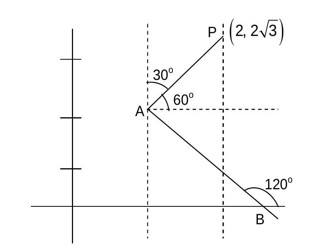Ncert Solutions Maths class 11th
Get insights from 1.6k questions on Ncert Solutions Maths class 11th, answered by students, alumni, and experts. You may also ask and answer any question you like about Ncert Solutions Maths class 11th
Follow Ask QuestionQuestions
Discussions
Active Users
Followers
New answer posted
2 months agoContributor-Level 10
Family of planes: x+y+z+1+? (2x-y+z+3)=0. Parallel to line means dot product of normals is zero.
New answer posted
2 months agoContributor-Level 10
Average speed = (f (t? )-f (t? )/ (t? -t? ) = a (t? +t? )+b.
Instantaneous speed = f' (t)=2at+b.
2at+b=a (t? +t? ) ⇒ t= (t? +t? )/2.
New answer posted
2 months agoContributor-Level 9
α, β are roots of x²+5√2x+10=0. α+β=-5√2, αβ=10.
P? + 5√2P? + 10P? = 0.
So P? +5√2P? =-10P? P? +5√2P? =-10P?
Expression = P? (-10P? )/P? (-10P? ) = 1.
New answer posted
2 months agoContributor-Level 10
m (AP)=tan60°=√3. y-2√3=√3 (x-2). At x=1, y=√3. A= (1, √3).
m (AB)=tan120°=-√3. y-√3=-√3 (x-1) ⇒ √3x+y=2√3. (3, -√3) satisfies
New answer posted
2 months agoContributor-Level 9
| Class | No. of students | Number of possible cases |
| :-: | :-: | :- |
| 10 | 5 | (I) 2 | (II) 3 | (III) 2 |
| 11 | 6 | (I) 2 | (II) 2 | (III) 3 |
| 12 | 8 | (I) 6 | (II) 5 | (III) 5 |
Total cases =? C? *? C? *? C? +? C? *? C? *? C? +? C? *? C? *? C?
= 23,800 = 100K
∴ K = 238
New answer posted
2 months agoContributor-Level 10
Equation of tangent to y²=4 (x+1) is y=m (x+1)+1/m.
Equation of tangent to y²=8 (x+2) is y=m' (x+2)+2/m'.
m'=-1/m.
Solving for intersection point, x+3=0.
New answer posted
2 months agoContributor-Level 9
sinx+sin4x + sin2x+sin3x = 0
2sin (5x/2)cos (3x/2) + 2sin (5x/2)cos (x/2) = 0
2sin (5x/2) [cos (3x/2)+cos (x/2)] = 0
4sin (5x/2)cosxcos (x/2)=0.
sin (5x/2)=0 ⇒ 5x/2=kπ ⇒ x=2kπ/5. x=0, 2π/5, 4π/5, 6π/5, 8π/5, 2π.
cosx=0 ⇒ x=π/2, 3π/2.
cos (x/2)=0 ⇒ x=π.
Sum = 9π.
New answer posted
2 months agoContributor-Level 9
S? = 3n/2 [2a+ (3n-1)d]. S? = 2n/2 [2a+ (2n-1)d].
S? =3S? ⇒ 3n/2 [2a+ (3n-1)d] = 3 (2n/2) [2a+ (2n-1)d].
2a+ (3n-1)d = 2 [2a+ (2n-1)d] ⇒ 2a+ (n-1)d=0.
S? /S? = (4n/2 [2a+ (4n-1)d]) / (2n/2 [2a+ (2n-1)d]) = 2 [- (n-1)d+ (4n-1)d]/ [- (n-1)d+ (2n-1)d] = 2 (3n)/ (n)=6.
New answer posted
2 months agoContributor-Level 9
Hyperbola: 16 (x+1)² - 9 (y-2)² = 144. (x+1)²/9 - (y-2)²/16 = 1. Center (-1,2).
Foci (-1±ae, 2). a²=9, b²=16. e²=1+16/9=25/9, e=5/3. ae=5. Foci (4,2), (-6,2).
Centroid (h, k) of P, S, S': P (3secθ-1, 4tanθ+2).
h= (3secθ-1+4-6)/3 = secθ-1. k= (4tanθ+2+2+2)/3 = (4/3)tanθ+2.
(h+1)² - (3 (k-2)/4)² = 1. 16 (x+1)²-9 (y-2)²=16.
16x²+32x+16-9y²+36y-36=16. 16x²-9y²+32x+36y-36=0.
Taking an Exam? Selecting a College?
Get authentic answers from experts, students and alumni that you won't find anywhere else
Sign Up on ShikshaOn Shiksha, get access to
- 65k Colleges
- 1.2k Exams
- 679k Reviews
- 1800k Answers

